Recognizing rhetoric in science policy arguments
Abstract
Diligent citizens must critically analyze arguments for science policy recommendations, such as cutting greenhouse gas emissions or growing genetically modified food crops. Science policy articles present arguments for and against such recommendations using scientific evidence and rhetorical devices. In this paper we present an in-depth analysis of argumentation and rhetorical devices in two journal articles on climate change issues. One objective was to gain a better understanding of use of rhetorical devices in this genre, as a prerequisite for designing and building a rhetorically-annotated digital corpus of full-text science policy articles. The near term objective was to inform the design of pedagogical tools to help students analyze science policy arguments.
1.Introduction
Diligent citizens must critically analyze arguments for science policy recommendations, such as cutting greenhouse gas emissions or growing genetically modified food crops. Science policy articles present arguments for and against such recommendations using scientific evidence and rhetorical devices. In this paper we present an in-depth analysis of argumentation and rhetorical devices in two journal articles on climate change issues [10,11]. The articles present policy recommendations to a science/technology-literate audience. We represent the propositional content of the main arguments and the rebuttals to potential counterarguments. In addition, we identify the rhetorical devices used in these arguments. Rhetorical devices can make text more salient, more engaging, evoke an emotional response, or convey an argument in abbreviated form [4]. In fact, rhetorical devices play a key role in the persuasiveness of science policy arguments.
One objective of the analysis was to gain a better understanding of use of rhetorical devices in this genre, as a prerequisite for designing and building a rhetorically-annotated digital corpus of full-text science policy articles. An in-depth analysis was necessary since we had found no published computation-oriented rhetorical analyses or rhetorically-annotated digital corpora of science policy articles. (See the next section on related work.) In the future the corpus could be used, e.g., for computational research on rhetorical figure detection, argument mining, and persuasion. The results of that research could, in turn, support a new generation of tools to help citizens to evaluate science policy proposals. In the near term, the analysis was intended to serve as a starting point for the design of an educational system to help students analyze science policy arguments.
A number of educational computer systems have been developed to support development of argumentation skills [12,19,20]. Some educational systems support argument comprehension through the use of argument diagramming, e.g. [14]. However, an argument’s presentation in a text, including its use of rhetorical devices, may influence its persuasiveness. The ability to recognize rhetorical devices is important, since studies have shown that students may favor presentation style over content in evaluating argument strength [3]. Yet pedagogical support for analysis of rhetoric has largely been neglected in educational argument systems. The exception is use of linguistic text analysis tools to help students visualize the role of lexical repetition and semantic relatedness in straw man arguments [18]. Lexical repetition and semantic relatedness are but two of many types of rhetorical devices. Thus, our near term goal is to develop an educational system that supports not only argument diagramming but also identification of a variety of rhetorical devices in science policy articles.11
2.Related work
The natural language processing research literature has overloaded the term rhetoric. Rhetorical Structure Theory [15] describes discourse coherence relations. For mining scientific abstracts and full-text articles, researchers have developed a variety of types of text classification schemes described as rhetorical, e.g., see the survey in [17]. But none of the above is concerned with rhetorical analysis in the sense of this proposal, which is informed by computational and classical rhetoricians.
The rhetorical devices identified in our analyses are based on descriptions in two recent studies in Argument and Computation [8,16] and a rhetorical handbook for writers [5]. In the Waterloo Rhetorical Figure Ontology (RhetFig) [8], rhetorical figures are classified as schemes (various phonetic, lexical, and syntactic patterns), tropes (figures involving semantics such as metaphor), chroma (figures involving pragmatics such as rhetorical questions and sarcasm), and moves (discourse patterns such as counterargument-rebuttal). In the analysis of the two articles presented here we have identified figures from each category. Mehlenbacher [16] argues that the rhetorical move of prolepsis “can be understood both as a rhetorical figure and as an argument strategy”. In our analysis, we identified occurrences of two of the proleptic rhetorical argument strategies she describes: Protocatalepsis and Prolepsis as Presage. The rhetorical figure annotation system proposed in [9] accommodates the description of compound rhetorical figures, where multiple figures overlap within the same span of text, which were found in our analyses.
There are no corpora of full-text science policy articles in which rhetorical figures have been annotated for computational research. Note that RhetFig [8] does not provide a corpus of annotated full-text articles; instead the goal was to provide multiple examples of each figure from a variety of sources. A limited amount of research has been done on automatic detection of rhetorical schemes and tropes; for surveys see in [9,13]. Researchers have begun to investigate how automatically detected rhetorical figures could be used for argument mining [13].
3.Ocean acidification article
An article by Johnson and White [10] concerns the problem of increasing ocean acidification (OA). The structure of the argumentation in the article is shown in Figs 1–3. As shown in Fig. 1, the main policy recommendation is for the reduction of emissions of carbon dioxide into the atmosphere, which is expressed in the last paragraph (¶21) of the article. We analyze the main argument for that recommendation as an instance of a Value-Based Practical Reasoning scheme [1,6,21]. Values underlying the argument include nature’s beauty, biodiversity, protection of the marine environment, food security, human health, and economic security. The premise that increasing atmospheric carbon dioxide is causing an increase in ocean acidification is given in ¶3 and supported by instances of Argument from Cause to Effect and Argument from Correlation [21] given in ¶3 and ¶4. The premise that increasing OA is a serious problem is given in ¶4 and supported with evidence in ¶5–14. Five counter-arguments and their rebuttals (represented as boxes in Fig. 1 labeled 1–5) are shown in Figs 2 and 3.
Fig. 1.
Main arguments in “Ocean acidification: The other climate change issue”.
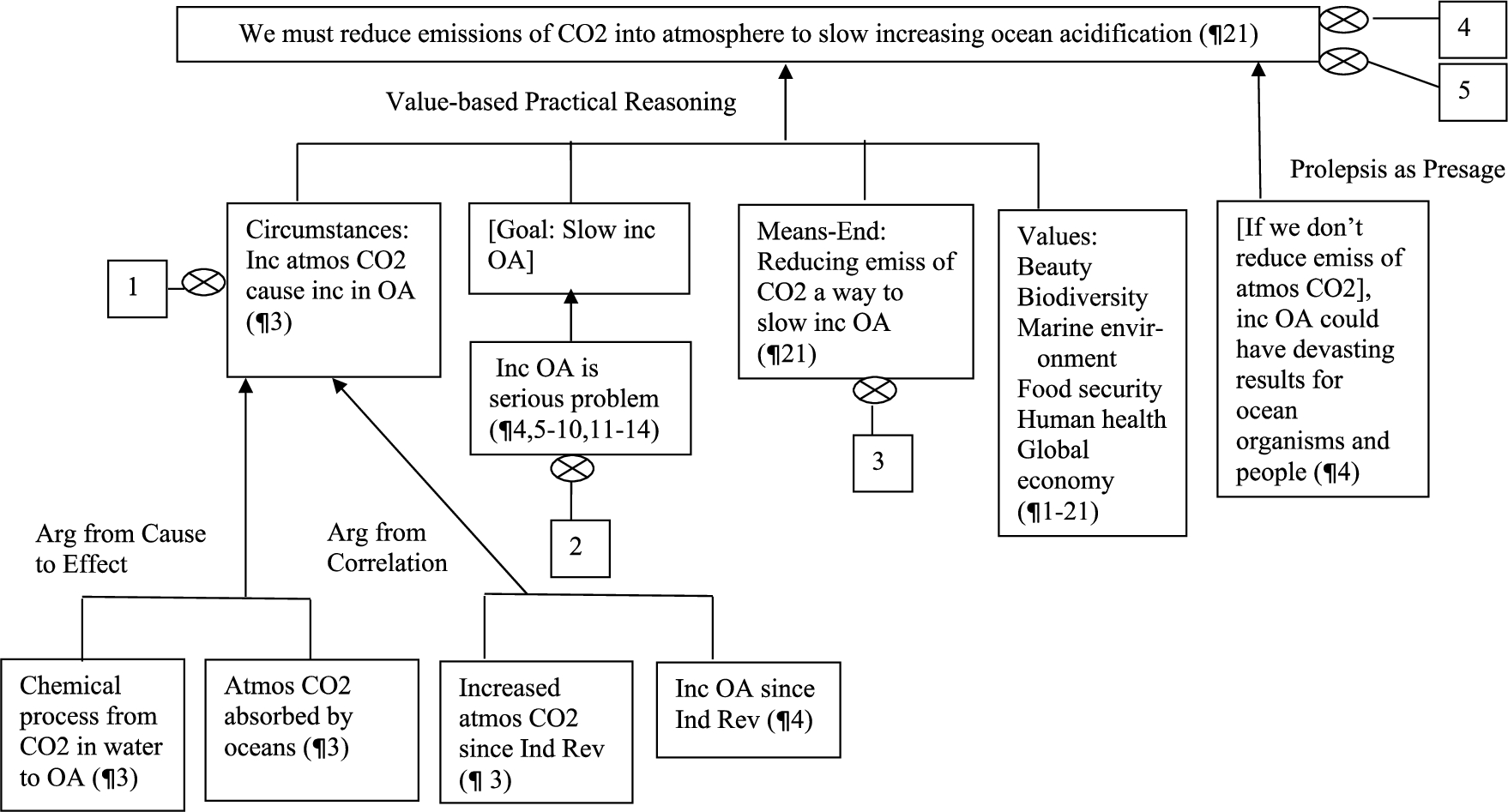
Fig. 2.
Rebuttals 1–3 in “Ocean acidification: The other climate change issue”.
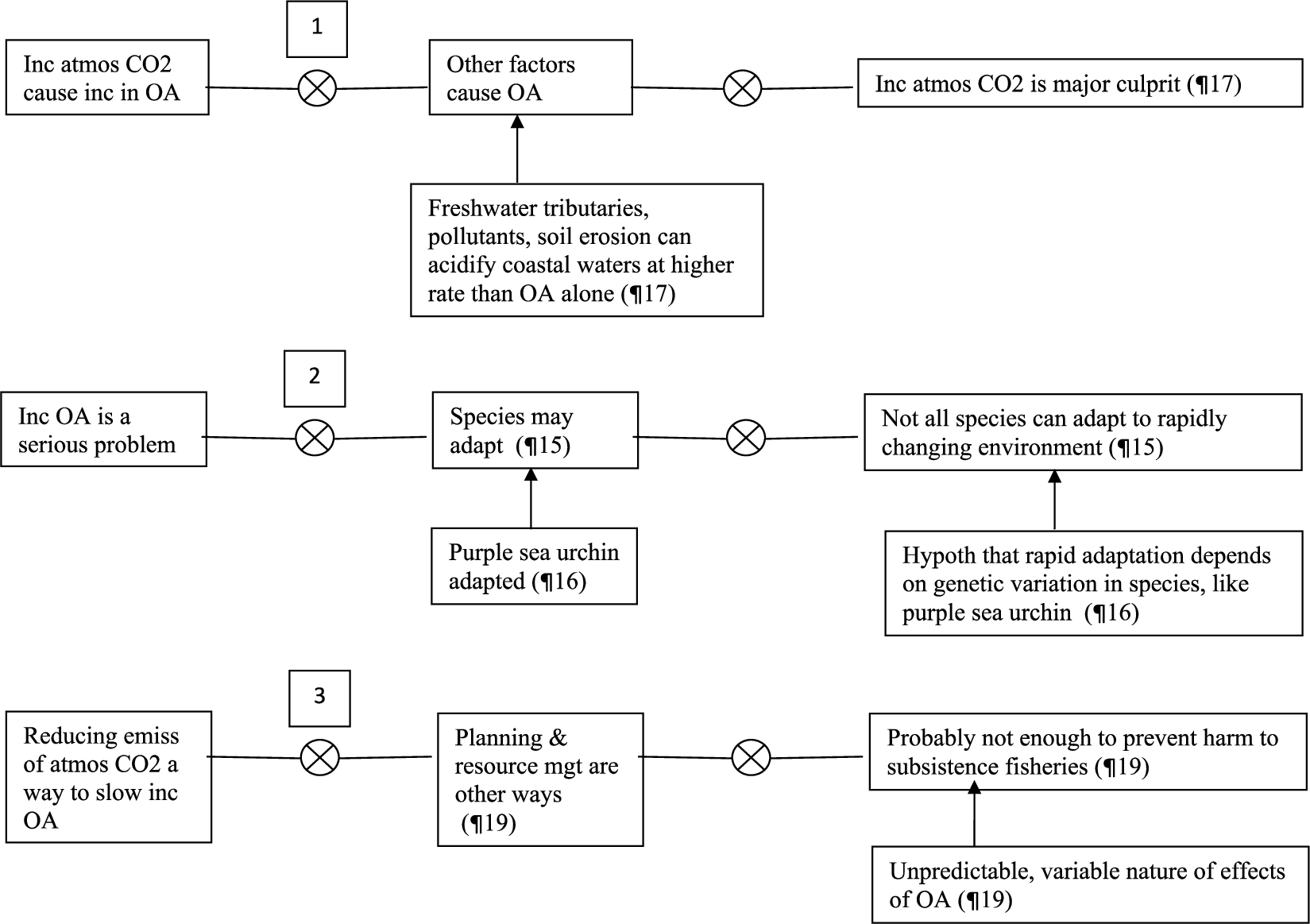
Fig. 3.
Rebuttals 4–5 in “Ocean acidification: The other climate change issue”.
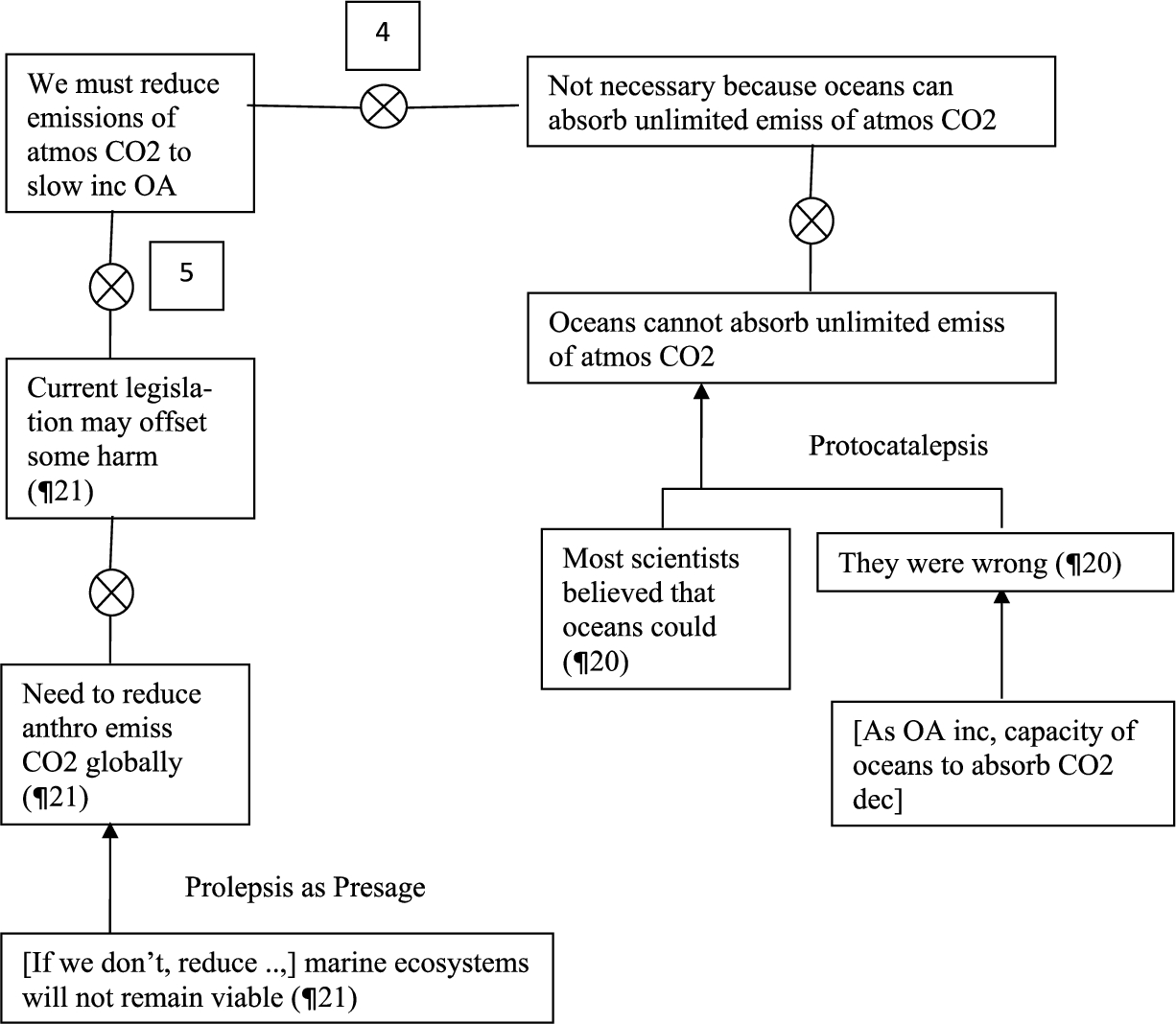
Although ¶3 and ¶4 play a role in the policy argument described above, the untitled opening section of the article (¶1-4) also plays a large role rhetorically. As noted in analyses of other environmental writing [16], the introduction first engages the reader with a fable-like warning of environmental catastrophe. Consider ¶1:
Within Earth’s vast oceans exists a diverse population of beautiful creatures that depend on a delicate balance of chemistry to remain viable. The tiniest animals are often the most important and underestimated species in any environment; they also are among the most vulnerable.
As a whole this paragraph can be interpreted as an enthymematic Value-Based Practical Reasoning argument, expressing the premise that some ocean species are threatened by changes in ocean chemistry, and through word choice (diverse population, beautiful creatures, underestimated species) expressing the value of biodiversity. The implicit conclusion of the enthymeme is that the reader should do something to prevent harm to ocean life. The enthymeme signals the authors’ values and their position on climate change.
Consider ¶2:
In the frigid waters of the Southern Ocean, off the coast of Antarctica, one such creature is the pteropod, Limacina helicina antarctica. These pea-sized marine snails, popularly known as sea butterflies because they appear to be using two “wings” when they swim, serve as a major food source for commercial fishes such as pink salmon. Yet this crucial resource is on the wane, as increasing levels of acid in the ocean threaten to dissolve its aragonite shell and impair its normal development.
The fable-like style continues in ¶3, beginning with a left-branching syntactic construction and referring to an historical event (More than 200 years ago, people developed a variety of machines to accomplish tasks traditionally completed by hand). Use of the compound rhetorical figures of antithesis and parison (great advances/steep price) here suggests the stereotypical ironic twist in fables in which a protagonist’s rise is followed by defeat. As shown in Fig. 1, this paragraph conveys an Argument from Cause to Effect, one of whose premises is conveyed in the sentence, Most carbon dioxide remains in the air, but as much as 25 percent is absorbed by the world’s oceans. The sentence is an instance of another compound figure of antithesis and parison (most remains/as much as 25 percent is absorbed), a function of which is to make a concession in anticipation of a rebuttal that carbon dioxide remains in the air.
The fable continues in ¶4 with another historical reference (Since the start of the Industrial Revolution) in a figure of parison with the opening of ¶3 (More than 200 years ago/Since the start of the Industrial Revolution). This historical reference plays a role in the Argument from Correlation shown in Fig. 1. In addition, ¶4 contains two shorter and thus rhetorically salient phrases (That is a huge change: a 150-percent increase in acidity.), emphasizing the premise of the article’s main argument, shown in Fig. 1, that increasing OA is a serious problem. The last sentence (Such an alteration in the marine environment could have devasting results both for ocean organisms and for the people who depend on them) can be analyzed as a rhetorical argument of Prolepsis as Presage, ending the fable with a warning and potentially evoking the reader’s emotion. As the final sentence, it is in a position of rhetorical prominence, and contains a compound figure of partial antimetabole (reverse repetition) (ocean organisms/people/them [ocean organisms]) and parison (both for/and for).
Compared to the introduction, the body of the article (¶5–19), which describes the causes and consequences of OA in scientific detail, uses few rhetorical devices. However, the relatively high frequency of phrases containing the root ‘acid’ (acid, acidified, acidification, acidity) and the root ‘carbon’ (carbon, carbonate) and related terms (CO2), is significant; so is the relatively high count of words evoking danger or harm (threat, vulnerable, toxic, damage, etc.). Such repetition is a rhetorical device that makes the association between OA and its negative consequences salient.
¶15 contains a rhetorical question (If ocean acidification continues as expected, can evolution offer a key to the health of marine organisms?). The question is followed by the potential counterargument (see box 2 in Fig. 2) that (some/most/all?) species may adapt to OA, as did the purple sea urchin. This is rebutted with an argument in ¶15–16 that rapid adaptation may depend on genetic variation, ending the paragraph with the short, salient, sentence (this is the probable explanation for their chemical tolerance). Two more counterarguments (see boxes 1 and 3 in Fig. 2) are given in ¶17–19.
The use of rhetoric picks up in the last section (“Safeguarding Ocean Chemistry”, ¶20–21), which contains two counterarguments and their rebuttals (see boxes 4 and 5 in Fig. 3). One rebuttal (¶20) is an instance of the rhetorical argument of Protocatalepsis, paraphrased in large font outside of the body of the text (Most scientists believed the carbon storage capacity of the oceans to be nearly limitless. They were wrong). The other rebuttal, expressed in ¶21, is a second instance of Prolepsis as Presage. The last paragraph also contains a compound figure of double antithesis and parison (certain marine species are vulnerable to acidification/others are relatively resilient), and three instances of parison (Using/Confronting, public awareness/clear interpretation/reasoned prediction, to offset the harm already done/to ensure that marine ecosystems remain viable). The last, and thus rhetorically salient sentence of ¶21 expresses the main policy recommendation of the article.
4.Solar geoengineering article
An article by Keith [11] argues in favor of research on solar geoengineering, “a process by which humans might deliberately reduce the effect of heat-trapping greenhouses gases, particularly carbon dioxide, by reflecting a small fraction of sunlight back to space.” The argumentation structure for that proposal is shown in Figs 4–6. As shown in Fig. 4, in ¶1–6 of the untitled opening section, the article gives an argument for employing solar geoengineering, combined with cutting greenhouse gas emissions, as a means of reducing global warming. This recommendation, in turn, is a premise of an argument for beginning research on solar geoengineering in the rest of the section (¶6–10). We have labeled the argument for research as V-B PR (Value-Based Practical Reasoning) Knowledge Precondition since the recommendation for the action of beginning research arises from the knowledge precondition [2] to know more about the technology before it can be deployed. Numerous counter-arguments to the two recommendations are shown in Figs 5 and 6.
Fig. 4.
“Towards a responsible solar geoengineering research program” introduction (¶1–10).
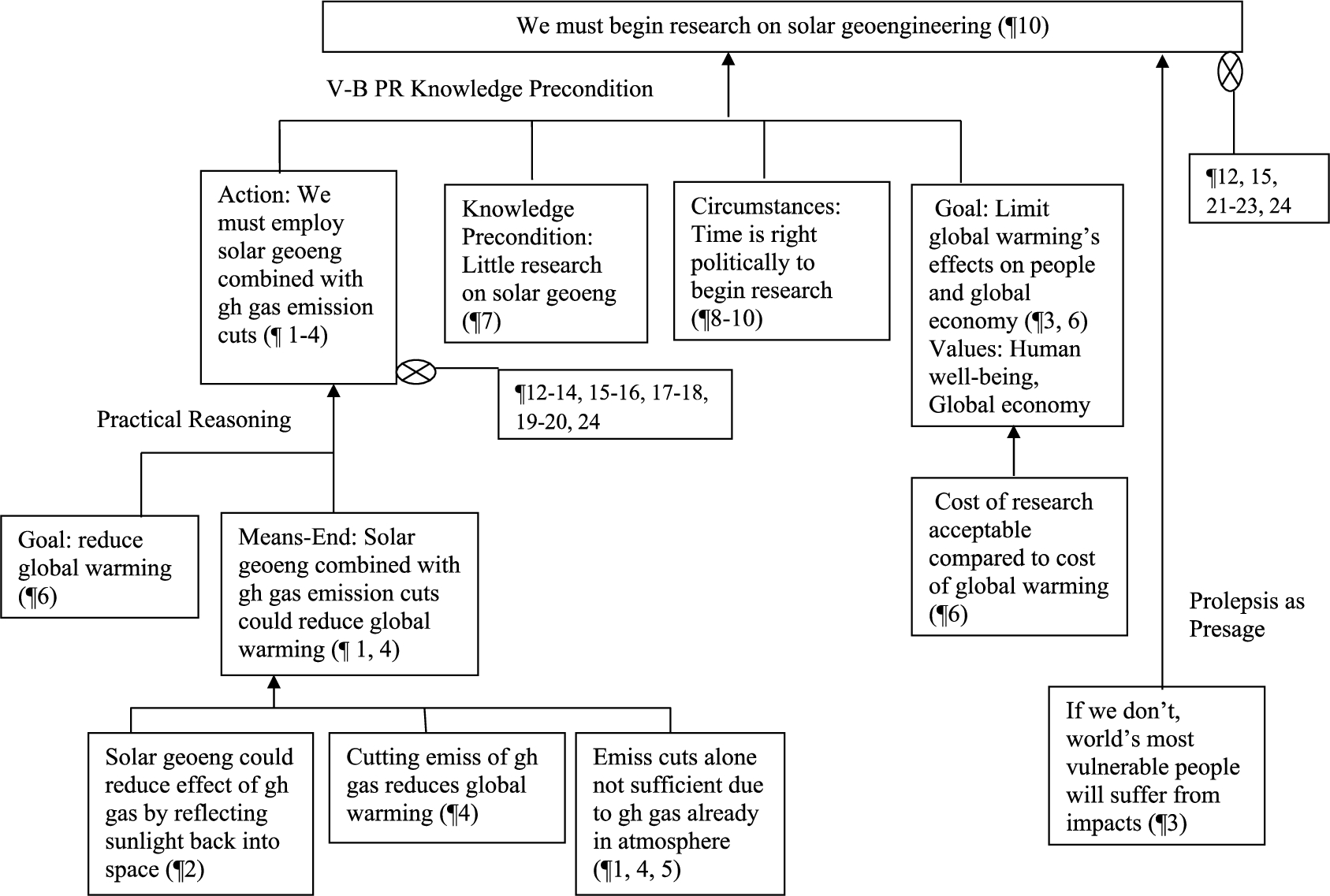
Fig. 5.
“Towards a responsible solar geoengineering research program: Reasons for reluctance”.
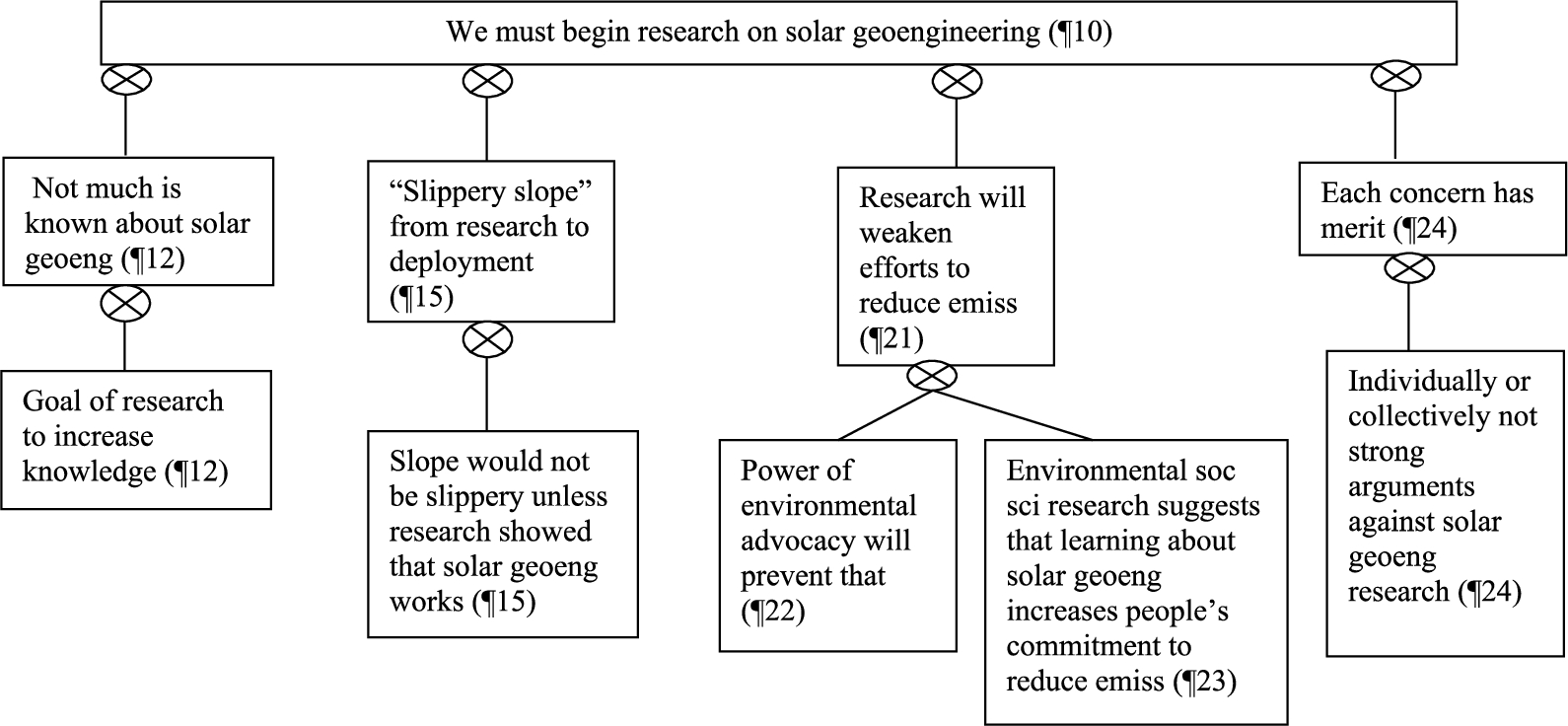
Fig. 6.
“Towards a responsible solar geoengineering research program: Reasons for reluctance” (continued).
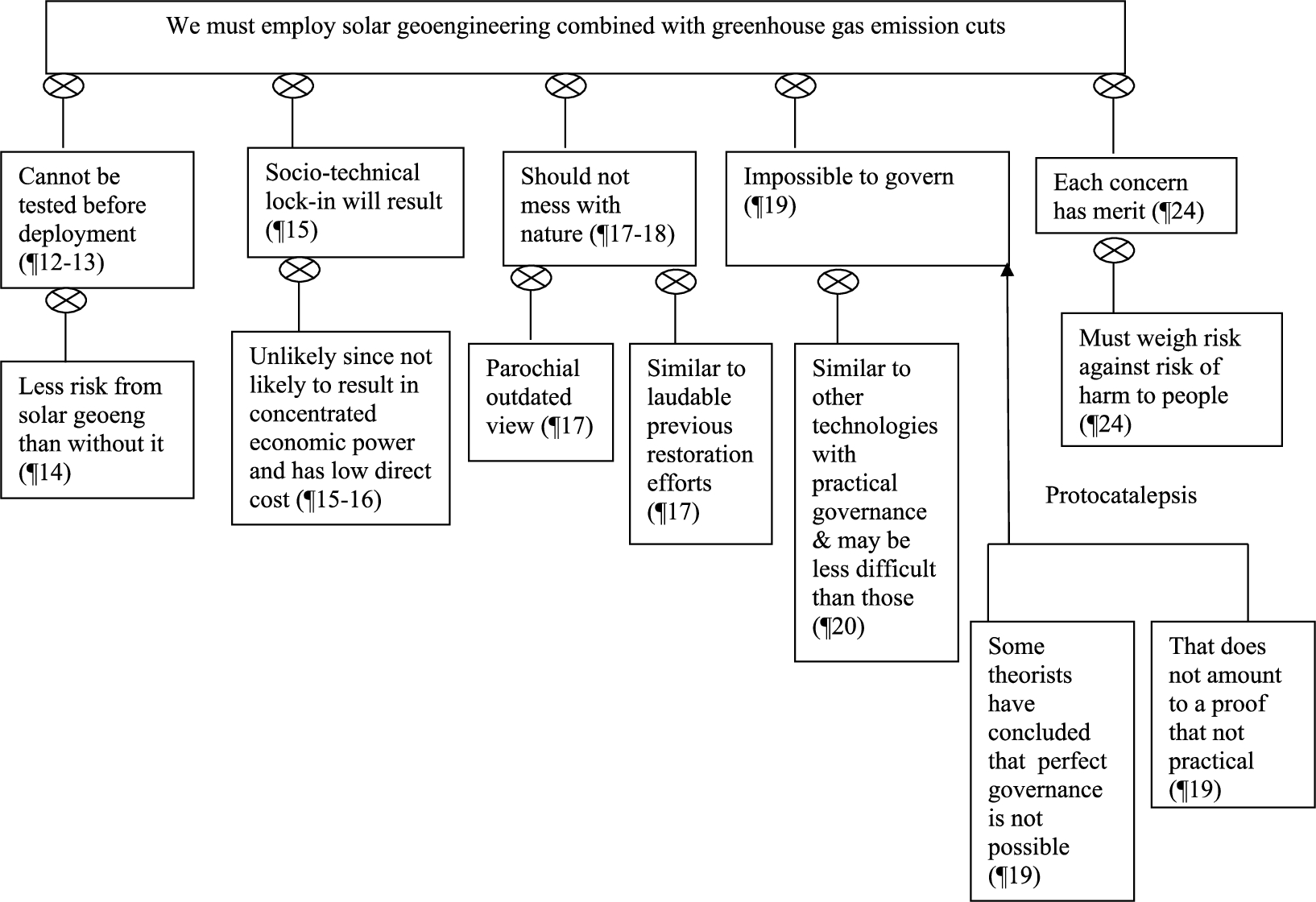
As in the article discussed in the previous section [10], the untitled opening section of [11] (¶1–10) also plays a large role rhetorically. The third paragraph contains a rhetorical argument of Prolepsis as Presage for research on solar geoengineering (shown in Fig. 4). The argument is made more salient by use of a compound figure of parison and antithesis (most powerful impact/most vulnerable people) and by the relatively shorter length of the paragraph. The fourth paragraph supports the premise that solar geoengineering combined with emission cuts is a way to reduce global warming. In this paragraph, repetition of risk(s) and emissions creates an association between climate risks and greenhouse gas emissions. Support for solar geoengineering combined with emissions cuts is repeated in the short, salient fifth paragraph:
Solar geoengineering is not a substitute for cutting emissions. It is – at best – a supplement. We can’t keep using the atmosphere as a free waste dump for carbon and expect to have a safe climate no matter what we do to reflect away some sunlight.
The longer, sixth paragraph details the cost-benefit of research on solar geoengineering compared to the cost of global warming. The phrase economic damage is repeated three times. The cost-benefit is summed up with a compound figure of antithesis and parison (modest research effort/rapid progress [of research]). In contrast, the next paragraph (¶7) is short – one sentence – and it employs a rhetorical figure of parison (there is
Yet despite this promise, there is very little organized research on the topic, and there is no US government research program.
The next section of the article (“Reasons for Reluctance”) provides numerous rebuttals to potential objections to the recommendation to begin research on solar geoengineering (see Fig. 5) and to the recommendation to use solar geoengineering combined with emission cuts (see Fig. 6). Like the opening, this section is rich in rhetorical devices.
Under the subheading “Uncertainty”, the objection that it is risky to use the technology since it cannot be tested before it is actually deployed (Fig. 6) is addressed in ¶12-14. Rhetorical questions (
No one knows. Uncertainty is baked into either path. But a reasonable first guess is that because RF is the central driver of climate change, there is less climate risk in the world with less RF. Uncertainty is real, but it speaks louder as an argument for rather than against research.
Under the subheading “Slippery Slope”, ¶15 addresses the objection that once research has begun, it will not be possible to prevent deployment of solar geoengineering technology (Fig. 5). This objection is expressed with a rhetorical figure of antimetabole (reversal) (research/slippery//slipperiness/research). Another objection addressed in ¶15–16 is that socio-technical lock-in will result (Fig. 6).
Under the subheading “Messing with Nature”, the next two paragraphs (¶17–18) address the objection that we should preserve nature (Fig. 6). The first rebuttal indirectly attacks holders of that view, calling it “a particularly North American nineteenth-century view”. The second rebuttal is that use of solar geoengineering is comparable to other environmental restoration programs that are regarded positively. This is expressed via rhetorical questions, sarcasm, and analogies:
If solar geoengineering reduces the climate and ecological effects of accumulated carbon dioxide, is its implementation a step toward cleaning up our mess in a process of ecological management at planetary scale? Or is it yet another step toward the subjugation of nature for human ends? Which analogy fits best: reintroducing wolves to Yellowstone? Restoration of the Florida Everglades in arguably the world’s largest and most costly environmental engineering effort? Reviving wooly mammoths? Or is geoengineering more akin to indoor ski slopes in Dubai, the creation of artificial environments to suit human whims?
Under the subheading “Moral Hazard”, ¶21–23 address the concern that research on solar geoengineering will weaken public support for cutting emissions (Fig. 5). In ¶21, in a figure of conciliato, the author identifies with others who have raised this concern (I share this fear
A second rebuttal, in ¶23, is that learning about solar geoengineering may increase the public’s awareness of climate risks and thus increase commitment to emission cuts. This is expressed first by presenting two “extreme reactions” in the form of satirical statements from imaginary members of the public, e.g., Great! A technofix! Now I can buy a big truck and ignore the environmental extremists. The statements are followed by a short phrase conceding We cannot know yet which response would prevail but citing experiments by social scientists in support of the author’s view.
The final paragraph of the “Reasons for Reluctance” section (¶24) concedes that although “each of the concerns described above has merit” they are not sufficient to defeat the arguments for research (Fig. 5) or on use of solar geoengineering (Fig. 6). Also, as shown in Fig. 6, it repeats the proleptic argument that solar geoengineering could avert harm to some of the world’s most vulnerable people. Salient in position and salient due to its short length, this paragraph ends with a compound figure of antithesis and parison (do suggest/do not amount to).
Table 1
Instances of some of the rhetorical devices in the two articles
| Rhetorical device | Ocean acidification | Solar geoengineering |
| Analogy | X | |
| Antithesis + Parison | X | X |
| Antimetabole ± Parison | X | X |
| Conciliato | X | |
| Fable (left-branching, enargia, reference to past time) | X | |
| Last phrase/paragraph | X | X |
| Metaphor | X | X |
| Parison (alone) | X | X |
| Prolepsis as Presage | X | X |
| Protocatalepsis | X | X |
| Repetition of key words | X | X |
| Rhetorical question | X | X |
| Irony, sarcasm or satire | X | |
| Short phrase/paragraph | X | X |
5.Discussion
There are some interesting similarities and differences in the use of rhetorical devices in the two articles. The introduction and ending of both articles make heavy use of rhetorical devices. Although both articles employ proleptic figures, by its use of a fable the introduction of [10] seems designed to appeal to emotion more so than the introduction of [11]. Another similarity is that rhetorical devices are associated with rebuttals in both articles. However, in [11] rebuttals are expressed in a more adversarial style than in [10], e.g., using rhetorical devices of irony, sarcasm and satire.
A primary objective of the analyses was to gain a better understanding of uses of rhetorical devices in this genre, as a prerequisite for designing and building an annotated corpus of full-text science policy articles for computational research. The analyses demonstrated usage of a wide range of rhetorical devices (some of which are listed in Table 1) that we intend to annotate in our first version of the corpus.22 Until we had done these analyses, we had no idea of the range of types and density of figures that would need to be accommodated. Furthermore, the analyses thoroughly demonstrated the need to use an annotation scheme such as described in [9] capable of handling compound rhetorical figures. We plan to use the corpus for research on automatic figure detection. Automatic figure detection could be incorporated into future on-line reading tools to enable readers to be aware of rhetorical devices used in science policy arguments. The hope is that the reader will then be able to judge the soundness of an argument regardless of the persuasiveness of its presentation.
Unfortunately, the two analyses failed to suggest how detection of rhetorical figures would be of much assistance in automatically extracting the main arguments shown in Figs 1 and 4 by current surface feature-based machine learning approaches to argument mining. Such an approach assumes that (1) after a text has been segmented into uniform units such as clauses, each segment can be reliably labeled (by human coders) as premise or conclusion (or neither) of an argument; and (2) that the presence of certain rhetorical figures within that segment correlates with the labeling of the segment. However, the first assumption does not hold in these two science policy articles. The propositional components of the arguments are expressed in sometimes non-contiguous, at times widely separated, or sometimes overlapping text segments of varying granularity, as was previously noted for bioscience research articles [7]. Another possible use of rhetorical features in argument mining would be, given that a block of text (multiple contiguous text segments) has been identified as expressing an argument, to identify the argument scheme. In the articles that we analyzed, since many common rhetorical devices were used within the main Practical Reasoning arguments, it is not clear that any of those devices uniquely correlate with that argument scheme. Nevertheless, we do not mean to discourage future argument mining research exploiting rhetorical device detection in this genre. For example, the role of rhetorical figures in detection of rebuttals merits further exploration.33
The near term objective of this study was to aid in designing an educational system to support a student’s analysis of both argumentation structures and rhetorical devices in science policy articles. The analyses presented here provide use cases for the design. As shown in Figs 1–6, the system must support a student’s creation of large and complex argument diagrams that feature chains of arguments, multiple arguments for the same conclusion, use of argumentation schemes, and rebuttals. Diagramming techniques used in current educational argument systems could be adapted for this. At the same time, the system must support a student’s markup in the text of each occurrence of a large number of types of rhetorical figures, many of which are compound figures (overlapping the same span of text). This will require the system to provide an intuitive44 text annotation tool, as well as an inventory of figures, their definitions, and examples.55 Although there are many more types of figures than those noted in this paper, our analysis of the two articles presented here is a good starting point.66 A significant challenge will be design of integrated visualizations of rhetorical devices and argument structures. Ideally, such visualizations could enable a student to appreciate whether rhetorical devices are used as an enhancement of or as a substitute for a well-reasoned argument.
Notes
1 The system is not intended for use in creating an annotated corpus; thus, the student would not be required to learn or apply annotations schemes. (One might use student analyses as a stepping stone towards that end, but that is not our goal.) Also, it is beyond the scope of our current work to develop an intelligent tutoring system that could evaluate the student’s work and provide automatic feedback. To develop such a system would require a “gold standard” annotated corpus, which does not exist currently. The current goal is simply to provide graphical user interface tools for students to record and visualize their analyses.
2 It is not yet clear which rhetorical figures should be annotated. Other computational researchers focused on a small set with “clear linguistic signaling” [13]. On the other hand, many of the figures illustrated here which, intuitively, play a role in the persuasiveness of the articles are not so clearly signalled. Another consideration is whether a figure can be described precisely enough to achieve high inter-rater agreement by corpus annotators.
3 Fahnestock has argued that a rhetorical figure may epitomize an argument [4], i.e., convey it in abbreviated form. It is not clear yet how to reconstitute the argument underlying a figure using state-of-the-art computational techniques, but that is also an interesting problem for future research.
4 I.e., not the powerful but complicated sort of tool used by professional annotators for creating corpora.
5 In the future, automatic figure detection could be used to supplement manual identification of figures by the student.
6 Educators using the system could contribute their own analyses of science policy articles to a shared repository.
References
[1] | T. Bench-Capon and K. Atkinson, Abstract argumentation and values, in: Argumentation in Artificial Intelligence, I. Rahwan and G.R. Simari, eds, Springer, Dordrecht, (2009) , pp. 45–64. doi:10.1007/978-0-387-98197-0_3. |
[2] | S. Carberry, Plan Recognition in Natural Language Dialogue, MIT Press, (1990) . |
[3] | D.S. Clayton and C. Gautier, Scientific argumentation in Earth system science education, Journal of Geoscience Education 54: (3) ((2006) ), 374–382. doi:10.5408/1089-9995-54.3.374. |
[4] | J. Fahnestock, Rhetorical Figures in Scientific Argumentation, Oxford University Press, (1999) . |
[5] | J. Fahnestock, Rhetorical Style: The Uses of Language in Persuasion, Oxford University Press, (2011) . |
[6] | I. Fairclough and N. Fairclough, Political Discourse Analysis, Routledge, London, (2012) . |
[7] | N.L. Green, Towards mining scientific discourse using argumentation schemes, Argument and Computation 9: (2) ((2018) ), 121–135. doi:10.3233/AAC-180038. |
[8] | R.A. Harris and C. Di Marco, Introduction: Rhetorical figures, arguments, computation, Argument and Computation 8: (3) ((2017) ), 211–231. doi:10.3233/AAC-170030. |
[9] | R.A. Harris, C. Di Marco, S. Ruan and C. O’Reilly, An annotation scheme for rhetorical figures, Argument and Computation 9: ((2018) ), 155–175. doi:10.3233/AAC-180037. |
[10] | A. Johnson and N.D. White, Ocean acidification: The other climate change issue, American Scientist 102: ((2014) ), 60–63. |
[11] | D.W. Keith, Toward a responsible solar geoengineering research program, Issues in Science and Technology 33: (3) ((2017) ). |
[12] | P.A. Kirschner, S.J. Buckingham Shum and C.S. Carr (eds), Visualizing Argumentation, Springer, London, (2003) . |
[13] | J. Lawrence, J. Visser and C. Reed, Harnessing rhetorical figures for argument mining, Argument and Computation 8: (3) ((2017) ), 289–310. doi:10.3233/AAC-170026. |
[14] | F. Loll and N. Pinkwart, Lasad: Flexible representations for computer-based collaborative argumentation, International Journal of Human–Computer Studies 71: (1) ((2013) ), 91–109. doi:10.1016/j.ijhcs.2012.04.002. |
[15] | W.C. Mann and S.A. Thompson, Rhetorical structure theory: Toward a functional theory of text organization, Text 8: ((1988) ), 243–281. |
[16] | A.R. Mehlenbacher, Rhetorical figures as argument schemes – The proleptic suite, Argument and Computation 8: (3) ((2017) ), 233–252. doi:10.3233/AAC-170028. |
[17] | M. Neves, D. Butzke and B. Grune, Evaluation of scientific elements for text similarity in biomedical publications, in: Proc. Fifth Workshop on Argument Mining, (2019) , pp. 124–135. |
[18] | K. O’Halloran, Digitally deconstructing ‘straw man’ and ‘wicker man’ arguments: A software-aided pedagogy, Argument and Computation 9: (3) ((2018) ), 193–222. doi:10.3233/AAC-180040. |
[19] | N. Pinkwart and M.B. McLaren (eds), Educational Technologies for Teaching Argumentation Skills, Bentham Science Publishers, (2012) . |
[20] | O. Scheuer, F. Loll, N. Pinkwart and B. McLaren, Computer-supported argumentation: A review of the state of the art, International Journal of Computer-Supported Collaborative Learning 5: ((2010) ), 43–102. doi:10.1007/s11412-009-9080-x. |
[21] | D. Walton, C. Reed and F. Macagno, Argumentation Schemes, Cambridge University Press, (2008) . |




